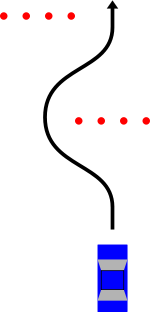
Moose test


The evasive manoeuvre test (Swedish: Undanmanöverprov; colloquial: moose test or elk test; Swedish: Älgtest, German: Elchtest) is performed to determine how well a certain vehicle evades a suddenly appearing obstacle. This test has been standardized in ISO 3888-2.[1]

Forms of the test have been performed in Sweden since the 1970s.[2] The colloquial and internationally better-known name for the test was coined in 1997 by the German newspaper Süddeutsche Zeitung after the Swedish motor magazine Teknikens Värld together with the TV-show Trafikmagasinet flipped a First generation Mercedes-Benz A-Class in a test ostensibly made to measure the car's ability to avoid hitting a moose.

In reality, the test is constructed to simulate, for example, a reversing car or a child rushing out onto the road.[3][4] This is because it is more likely that the moose will continue across the road than remain in place or turn back, making it more advisable to brake hard and try to slip behind the animal than to swerve in front of it.[5]

Test specifications
The test is performed on a dry road surface. Traffic cones are set up in an S shape to simulate the obstacle, road, and road edges. The car to be tested has one belted person in each available seat and weights in the boot to achieve maximum load. In order to qualify as a "pass" the vehicle must successfully navigate the course at 72 km/h (45 mph).[6]

When the driver comes onto the track, they quickly swerve into the oncoming lane to avoid the object and then immediately swerve back to avoid oncoming traffic. The test is repeated at an increased speeds until the car skids, knocks down cones, or spins around.

1997 Mercedes A-Class test
On 21 October 1997 the journalist Robert Collin from the motor magazine Teknikens Värld overturned the new (now First generation) Mercedes-Benz A-Class in the moose test at 60 km/h (37 mph), while a Trabant—a much older, and widely mocked car from the former East Germany—managed it perfectly.[7]

During an interview in Süddeutsche Zeitung, Collin tried to explain this test by the example of an evasive manoeuvre for a moose on the road. It was soon called Elchtest (moose test).[8]

Mercedes initially denied the problem, but then took the step of recalling all units sold to date (2,600), rebuilding 17,000 cars[9] and suspending sales for three months until the problem was solved by adding electronic stability control and modifying the suspension.[10] The company spent DM 2.5 billion in developing the car, with a further DM 300 million to fix it.[11]

Ongoing testing
Swedish automotive magazine Teknikens Värld tests "hundreds of cars every year".[2] with the moose test. It publishes test results since 1983 on their website.[12] The car with the slowest speed to successfully complete the manoeuvre is the Reliant Rialto at 42.5 km/h (26.4 mph).

In July 2005, the Dacia Logan appeared initially to fail the test, but a later investigation concluded that excessive testing had worn the car's tyres to failure.

Some current vehicles, such as the 2021–present Mitsubishi Outlander and Volvo XC40 Recharge T4, still fail this test, although after the latest software revision the RAV4 now passes the test.[6][13]

Current champion
The current record holder is the Porsche 718 Cayman GT4 RS Manthey at 86 km/h.[14]

Actual moose collision testing
Although the moose test itself is based on the avoidance of hitting an obstruction in the road, testing is also carried out on actual collision with animals in the road. Both Volvo and Saab have a tradition of taking moose crashes into account when building cars.[15]

The Swedish National Road and Transport Research Institute has developed a moose crash test dummy called "Mooses". The dummy (which is made with similar weight, centre of gravity and dimensions to a live moose) is used to simulate realistic moose collisions.

Australian car manufacturers use crash test kangaroo dummies for similar reasons.[16]

In a 2008 episode of Mythbusters, the urban legend that accelerating to hit a moose would cause less damage than braking was investigated and busted. It was found that regardless of car type and speed, the damage to a vehicle was catastrophic in all cases.

See also
References
- ^ "VEHICO Fahrroboter - Index".
- ^ a b Rabe, Mattias (10 July 2012). "How Jeep Grand Cherokee failed the evasive manoeuvre test". Teknikens Värld. Archived from the original on 13 December 2013.
- ^ Andersson, Sven-Erik (14 April 1998). "Så bra är de nya sommardäcken". Aftonbladet (in Swedish). Archived from the original on 22 November 2009. Retrieved 12 July 2012.
Aldrig tidigare har däck testats i "älgtest" – det test som fick Mercedes A-klass på fall. 40 meters körning mellan koner, och en tvär undanmanöver, som simulerar att till exempel ett barn (inte en älg) plötsligt kommer utspringande framför bilen." / "Never before have tyres been tested in "the moose test" - the test that brought down the Mercedes A-class. 40 meters of driving through cones, and a sharp evasive manoeuvre, that for example simulates a child (not a moose) suddenly rushing in front of the car.
- ^ Collin, Robert (15 November 2004). "Vältklassen". Aftonbladet (in Swedish). Archived from the original on 12 December 2013. Retrieved 12 July 2012.
- ^ "Trafikolyckor & olycksstatistik". Körkortonline.se (in Swedish). Retrieved 13 July 2013.
När en älg väl har börjat gå över vägen är sannolikheten störst att den fortsätter över vägen. Därför är det bäst att styra in bakom älgen, om du måste välja vilket håll du ska väja åt." / "When a moose has begun to cross the road, it is likely that it will continue across. Therefore it is best to steer behind the moose, if you have to choose what way to swerve.
- ^ a b "Toyota RAV4 Plug-in Hybrid performs dangerously in the moose test". Teknikens Värld (in Swedish). Retrieved 24 July 2022.
- ^ The Sydney Morning Herald (6 May 2005). "Petite feat - drive.com.au". The Sydney Morning Herald. Drive.com.au. Archived from the original on 19 July 2005. Retrieved 10 January 2012.
- ^ "Der Elchtester". Die Zeit (in German). Retrieved 14 November 2019. (Collin is wrongly spelled as Collins)
- ^ Michael Specht (2 November 2017). "Mercedes A class moose-test crisis recalled". Crain Communications, Inc. Retrieved 27 August 2020.
- ^ Andrews, Edmund (11 December 1997). "Mercedes-Benz Tries to Put a Persistent Moose Problem to Rest". New York Times. Retrieved 2 April 2013.
- ^ "Mercedes bends". The Economist. 13 November 1997. Retrieved 2 April 2013.
- ^ teknikensvarld.se
- ^ Alaniz, Anthony. "Toyota RAV4 Passes Moose Test After Software Update". Motor1. Retrieved 8 January 2023.
- ^ https://teknikensvarld.expressen.se/algtest/
- ^ "What Happens When You Actually Hit a Moose? Volvo Has a Moose-Strike Test for That". Car & Driver. 31 July 2018. Retrieved 3 July 2019.
- ^ "The Ford Discovery Centre". Intown Geelong. Retrieved 9 October 2012.
External links
- Swedish National Road and Transport Research Institute Archived 9 October 2016 at the Wayback Machine - Moose Crash Test Dummy
- Moose test - list of the fastest and slowest cars
See what we do next...
OR
By submitting your email or phone number, you're giving mschf permission to send you email and/or recurring marketing texts. Data rates may apply. Text stop to cancel, help for help.
Success: You're subscribed now !
